Today it became popular to use a variety of techniques and landscape design versions that suggest landing for all familiar plants and rather exotic cultures. Among the variety of decorative shrubs and trees often used in the landscape, there are those that can be found in almost any garden composition. It is to such plants that include Tui - evergreen coniferous plants that are firmly taken by the honorable place in any design.
The species and variety of Tui affects the imagination, so each gardener can easily choose for themselves the variety. Thuja Western Ringold is a bright representative of the entire family capable of making colorful and bright anyone, even the most gloomy, plot. This variety has long been loved by gardeners who try to inspire in their landscape to the landscape, landing and care for which is pretty simple.
In this article, consider the features and description of the Tui Ringold, as well as we note the important moments of planting and care for this culture. We present the main options for using a bright Tui variety in landscape design.
Features and morphological description Tui Ringold
Thuja is a decorative coniferous shrub, which has been very popular with the gardeners for many years, thanks to its unpretentiousness in care and excellent appearance. In total, this culture has 5 species, in moderate climates, the Thuja Western and her decorative varieties are most often grown. Western Thuja is a perennial, evergreen, a coniferous plant that belongs to the nature of the Tui and a large family of cypress. The natural area of \u200b\u200bhabitat of this kind of coniferous plant is the territory of North America, where the small trees of the Tui Western Ringold can be found in the lowlands, along the banks of the rivers, on the swamps, on lime soils and fertile sublinks.
Thuja Western Ringold is an evergreen decorative tree that bright stain decorates any plot. This type is characterized by its peculiar crown, which changes with age. Tui name Rheingold.it has a Latin origin and can literally translated as "Golden Rain". In fact, this is a literal description of the appearance of the Tui of this variety and the color of her needles, which throughout the season can change the shade several times: from pinkish to golden yellow and orange. The very name of Thuy received in 1753 from the famous botany Charles Linnei, who was the first to give a detailed description of this decorative plant. The word "Thuja" in the Greek denotes "sacrificing, anonymousness", which is associated with the ancient traditions of burning the fragrant branches of the Tui during rites.
Thuja Ringold, as a representative of Tui Western, was widespread in almost all climatic zones. This amazing cultural plant has become simply indispensable in the landscape design of any style.
Description Tui Ringold:
- Thuja Western Ringold or Thuja Occidentalis 'Rheingold' is an evergreen coniferous shrub plant, characterized by slow growth.
- The Motherland of this type of Tui is Germany, where the rangold variety was derived in about 1900 and has since received great popularity around the world.
- This is a dwarf form of the Tui, which has a huge decorative value due to the shade of its needles and the appearance of the crown of the plant.
- To the dwarf group of Thuja Ringold is due to the fact that most varieties of this culture in height can reach 4-5 meters in culture, and in nature and all 40 m. As for the specifically of this variety, the site such a coniferous plant can maximize 2.5 meters.
- In addition, the Thuja Western Ringold is characterized by extremely slow growth rates. By 10 years, the shrub can reach a height of 1 meter and the same diameter of the crown, which indicates that the increase in the year is only 10 cm. To the final height, which can sometimes be 3-4 meters, can reach 30-40 years .
- The coniferous shrub is formed by soft and short branches, which are thickly covered with needle foliage in young age and scaly foliage in more mature age.
- The needles of the Tui Ringold is one of the most important decorative decorations of the shrub. It is connected with a unique and very bright color of scales, which changes during the season. In the spring, young twigs are painted in a pinkish shade, which gradually becomes golden yellow, and in the fall of the branches, the bright orange or bronze shade is acquired, which will undoubtedly decorate any garden and a plot.
- In addition to the color of the needles, this type of Tui Western boasts the unique form of the crown, which is widely varied and varies through the growth of the coniferous shrub. In young age, you can observe a small and compact bushing with a pillow -den or semi-shaped form of the crown. Typically, such a crown is characteristic of the plant in the first 10-15 years. In the future, Krone gradually changes to the spherical and widespread, which can be observed in the plant for 20-30 years. Ultimately, Krone becomes cone-shaped and very dense.
- The root shrub system is compact, but at the same time quite powerful.
- In young branches, the red-brown bark, smooth, but over time it becomes gray-brown and starts separated by stripes.
- Once a few years of the needle of the Thui Ringold dies and falls on the ground with needles.
- Fruits are formed on the branches of the shrub, which are rounded brown shada beds. In diameter, one bump can reach 0.7 cm.
- Tui Ringold is distinguished by durability, as in one place this plant can grow up to 200 years.
- This decorative coniferous shrub is characterized by excellent frost resistance. It is believed to 3 climatic zone, which corresponds to -34-39 degrees.
Using Tui Ringold in Landscape Design
Thuja Western Ringold is a very decorative coniferous shrub, which is widely used by gardeners and landscape designers on household plots for the formation and creating a variety of unique compositions. Consider the most popular options for using the Tui Ringold.
- First of all, due to its dense and compact crown, this type of thuu is widely used to create beautiful molded alive hedges. In this way, a plot can be divided into several zones or make a natural fencing, or enter a similar living fence into the garden composition.
- Beautifully Thuja Ringold looks in solitary fittings. You can land a compact coniferous bush against the background of a green lawn, which will make the focus on an incredibly bright color of the conifers of the thuy.
- This plant is perfectly suitable for planting in various mixlers or groups from a variety of coniferous plants. Alternatively, you can land a rangold with other varieties of Western Tui, which have another touch of needles and another height.
- Many landscape designers advise the use of the Tuy Western Ringold as an important component of complex garden compositions with the participation of various ornamental shrubs and trees with different architectures.
- This kind of thuu is suitable for growing in pots and containers, as it refers to dwarf varieties. In this case, with the help of such plants, you can decorate the terrace or gazebo.
Reproduction of the Tui Ringold: the most common ways
Thuja Ringold is a beautiful and unpretentious plant, which can be used without problems independently at home. For this, it is only necessary to know the main methods of breeding and their rules. To reproduce the Tui Ringold, the reproduction of seeds and cuttings, as well as sprigs. As for the last method, it is much like the reproduction of Tui cuttings, but some features and differences still exist. Consider detailed instructions for the reproduction of this type of Tui Western in various ways.
Seed reproduction of Tui Ringold
- This method is most often used to reproduce the species tuy, since in the case of growing of seeds of varietal plants there is a chance to get a very new plant without saved maternal signs. However, you can experiment and try to grow a new and unusual plant from the Tui Seeds.
- Seed reproduction or generative method is considered a rather complicated and long-term process, which can stretch to 3-4 years. This must be taken into account if you wish to grow decorative from seeds.
- First of all, it is necessary to assemble the seeds of the Tui Ringold. For this, first of all, it is necessary to wait for the full ripening of plants cones, after which they are broken and thoroughly dried. Conventional maturation falls on October or November.
- Store seeds are not recommended, as they quickly lose their germination, so immediately the entire planting material must be used to obtain seedlings.
- To get more germs, all seeds of the thuu of this species must be subjected to the process of stratification. To do this, you can put them in the container with soil and put in the refrigerator.
- However, many gardeners recommend stratification on the street under the snow. To do this, in suitable boxes, a wet mixture of garden and turf, peat and sand is pushed.
- The surface of the soil is thoroughly smoothly and make the grooves on it with a maximum depth of 1 cm. At the same time, the distance between individual grooves should be approximately 5-6 cm.
- In these grooves close the seeds of the Tui Ringold and pour them with soil, after which the surface is compacted and moisturized from the spray.
- Next, the box with seeds are installed in the shade of trees.
- The first shoots can be seen already on the next spring after the total heat heating to 10-15 degrees. At the Tui Ringold needles at a young age needle, so you should not be frightened that you have grown at all of the wrong plant.
- Regularly needed to feed young seedlings with complex mineral fertilizer and constantly moisturize.
- When the seedlings are growing, they must be planted for a garden for frozen, pre-rooted it and supports mineral fertilizers.
- Further care for seedlings is the same until they reach a height of 50 cm. This is usually happening for 3 years. After that, the seedlings can be transferred to a permanent place.
The reproduction of Tui Ringold with stalling
- The most common way to obtain a large number of young Tui Ringold seedlings is a method of reproduction with cuttings.
- First of all, it is important to choose the right cuttings on an adult plant. They must be strong and mature, while not worth choosing too young or too old shoots.
- In reproduction cuttings, you can use the weed two or three-year-old shoots, from which the cuttings are 25-40 cm long.
- At the same time, experienced gardeners are recommended to properly harvest the cuttings for breeding the Tui. Do not cut them into a knife or a secateur. It is best to take the branch with your hands and just tear it with a sharp movement. Thus, on the end of the cutting, there will be a peculiar "heel" - a piece of the breast of the mother tree, which allows cuttings better to root.
- After that, from the bottom of the cuttings, all twigs and cheese are removed.
- Next, it is recommended to treat all sections with a root formator to speed up the rooting of the cuttings.
- It is important to prepare the optimal soil composition for rooting cuttings. It should consist of river sand, turf land and peat. This primer can be poured into a spacious container, which is further placed in a greenhouse.
- Next, the cuttings are rooted at an angle of 60 degrees in a prepared substrate. The depth of rooting should be no more than 2 cm.
- For quick and full rooting, it is important to maintain the temperature in the greenhouse within 23 degrees and regularly moisten the soil by the spraying method.
- When young shoots appear on the cuttings, they are well rooted. At this time, you can start to avoid your landings, water and loose, as well as make fertilizers.
- In the fall, such cuttings can be planted in an open ground to a permanent place, after which it is insulated with leaves, sawdust or fir legs before the onset of cold weather.
- With severe frosts, landing should be covered with a film or other underfloor material.
Planting Tui Ringold
Thuja Western Ringold is a beautiful and rather popular grade of a coniferous plant, which can be grown on any plots. The process of planting this plant is not distinguished by complexity and complexity, but it is important to carefully and competently carry out all the stages of preparation for landing and actually the landing itself for obtaining healthy and beautiful cookies. Consider detailed instructions for holding all stages of landing Tui Ringold.
Stage 1. Choose and purchase of the landing material Tui Ringold
- First of all, each gardener needs to acquire high-quality and healthy seedlings, which will depend on the further growth of the coniferous plant.
- Buy Saplings Tui Ringold can be in any specialized garden center or nursery, which is professionally engaged in breeding plants. In addition, many gardeners recommend buying zoned seedlings, i.e. Planting material that was obtained in your climatic conditions. So you will get hardened seedlings with good immunity.
- When buying a car's seedlings, the Ringold in the store can simultaneously receive professional advice on the rules of landing and care for this variety of Western Tui.
- Most often, the seedlings of this plant are sold in special pots, which is very convenient, as it is possible to plant them in open ground throughout the season.
- Before buying, be thoroughly inspecting the seedlings. There should be no visible damage to the branches, dried areas, as well as signs of diseases and pests. Soil in pots should also have a well-kept view. Be sure to make sure there is no mold on the soil.
Stage 2. Choosing a place for landing Tui Ringold
- A further step towards getting a beautiful and bright coniferous busty is the right choice of place for landing on your site.
- Thuja Western Ringold prefers to grow on an openly sunny place, as the golden needle must necessarily need a lot of light.
- You can plant this plant and in a light half, but the tone of the needles will not be so bright. In addition, the shadow of the thuu needles can become rarely and not so beautiful.
- The selected landing plot must be securely protected from strong wind and draft.
- Thuja of this species does not make close to the groundwater, so you need to pick up a slightly sublime place on the site or to build a small mound.
- Thuja Ringold perfectly tolerates the ranks and smalleriness of the air, so it can be planted in an urban feature.
- Before placing a variety of Ringold, it is important to decide on the desired landscape design, after which you can pick up for a coniferous beauty optimal place.
Stage 3. Choice and soil preparation for landing Tui Ringold
- Thuja Ringold prefers to grow on lungs and fertile soils with an acidity level within 4.6-5.
- For planting this plant, any soil is suitable: marsh, sugal, loamy, soup. However, the most ideal option is to land the Tui in a drunken ground, in which you can get a beautiful plant with a lush and compact crown.
- Also before landing it is important to correctly select the soil mixture, which should consist of a delicate or leaf land, peat and sand.
- Before landing, the selected area is important to prepare carefully. To do this, the place is drunk at about one bayonet shovel, after which the soil must be loosen and dissolved.
Stage 4. The process of landing Tui Ringold
- The best time for planting the thuu of this species is spring when the soil is completely warmed. This is usually the end of April or the beginning of May.
- At the prepared in advance, it is necessary to make landing pit. Their size must correspond to the size of the root seedlings along with the Earth, if they were bought in pots.
- In diameter, landing pits should be 60-80 cm, and the depth may reach up to 100 cm. In this case, it is necessary to remember if you land several seedlings nearby, then on 1, the meter should have two plants.
- If the soil is heavy and there is a close occurrence of groundwater, then at the bottom of each landing pit it is necessary to pour a layer of drainage. Such a layer should be approximately 15-20 cm. You can use clayjit, broken brick, small stones as a drainage. Drainage will prevent stagnation of moisture in the roots of the plant.
- Before the landing is important to prepare purchased seedlings. Young plants with open roots need to be lowered into a container with water for a while so that they have a moisture. Seedlings in containers need to be ached abundantly to facilitate their extraction.
- Further, in the prepared in advance, the soil mixture of the turf, peat and sand need to add 100 grams of nitroammofoski, after which it is half filled with this mixture each pit.
- This soil establishes a sapling of the Tui Ringold and put it with its remaining part of the nutrient soil, after which the surface is compacted. Fill seedlings in such a way that the root neck is on the same level with the surface of the soil.
- After landing, the seedlings should be abundantly pouring and clinging the rolling circle.
Agrotechnical cultivation of Tui Ringold: Secrets and Nuances of Care
The care of the Thuy Ringold is not difficult and lies in the simplest actions that eventually allow you to get a beautiful decorative plant.
- Watering. Thuja of this species is a moisture plant, therefore it is often necessary to water. Young bushes need to water once a week with 10 liters of water, 50 liters will be needed for adult plants. On average, it is necessary to water the same rangold 2 times a week, while you can navigate to the condition of the needles, which, with a lack of moisture, starts to dry. Young Tui also love sputtering, which in the arid summer is held almost every day early in the morning or in the evening.
- Loosening and mulching. Regular the next day after irrigation, it is necessary to loosen the soil in the coil circle. It is necessary to do it very carefully so as not to damage closely located roots. After loosening, you also need to be a mulch. To do this, use a dry peat or crushed bark.
- Feeding The first few years you can not feed, since it has enough nutrients made by landing. In the future, it is possible once in the season in the spring to plug into a rolling circle of humus and fertilize in spring and summer complex mineral fertilizers.
- Trimming. Thuja Ringold is distinguished by a compact and dense crown and with the correct outlines, so it does not need a special forming trimming. In addition, the plant grows very slowly. The only one, you will need to remove broken and damaged branches in spring.
- Preparation for winter. An adult plant of frost transfers well, but it is terrible solar burns, especially for young plants. Therefore, the rolling circle is necessary to mulch with leaves and spruce vegetable. Chew also better protect from the cold. To do this, you can make a wooden tripogue and wrap it with observer material.
- Diseases and pests. Thuja Reagold can sometimes be affected by fungal diseases, so for their prevention you can handle whole fungicides. From pests, the plant is most often damaged by a plane, a word, flapping, which can be struggling with insecticides.
Thuja Ringold - Photo
Thuja Western Ringold is a beautiful evergreen coniferous plant, which is perfect for decorating any site. Landing and care for this plant is quite simple, which allows you to grow this culture even inexperienced gardener.

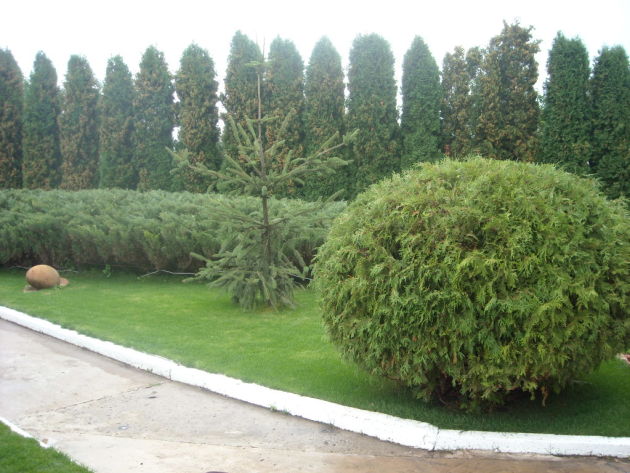
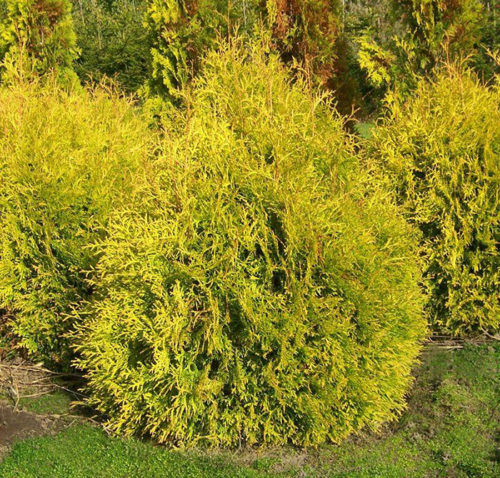

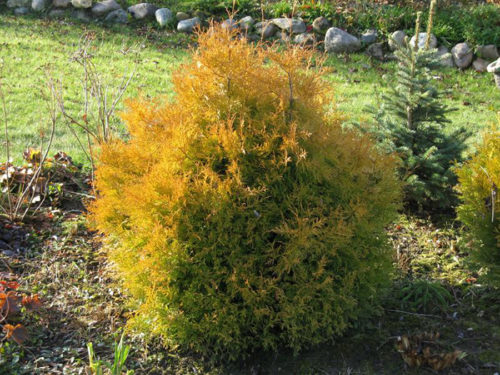
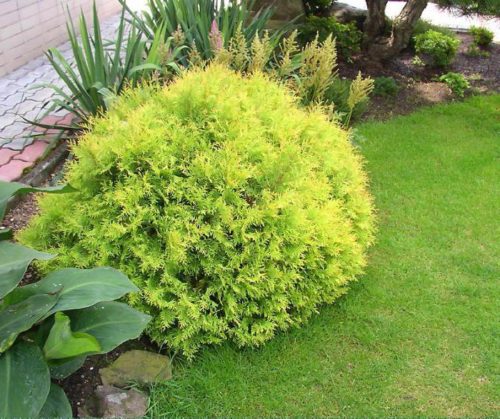
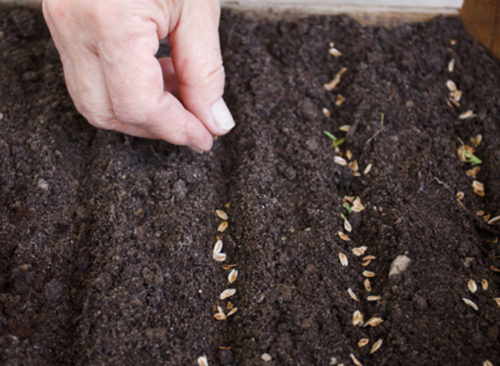
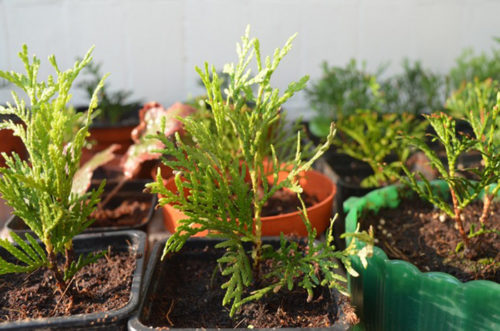
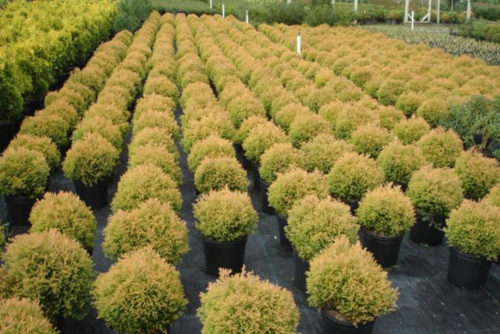
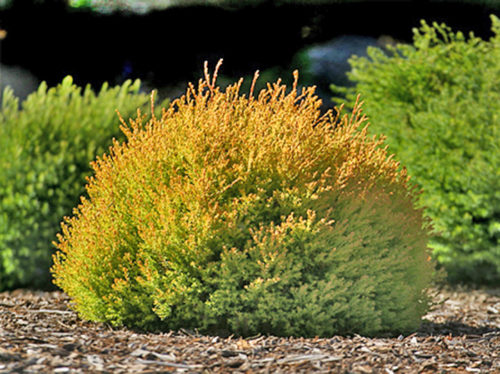
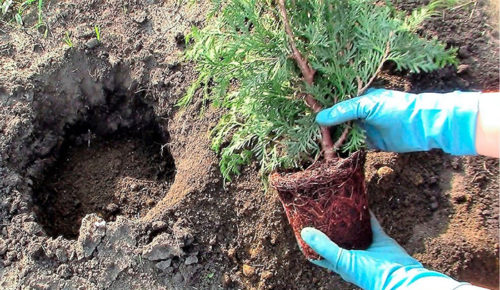
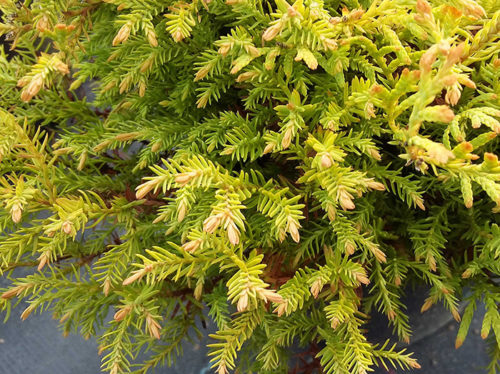
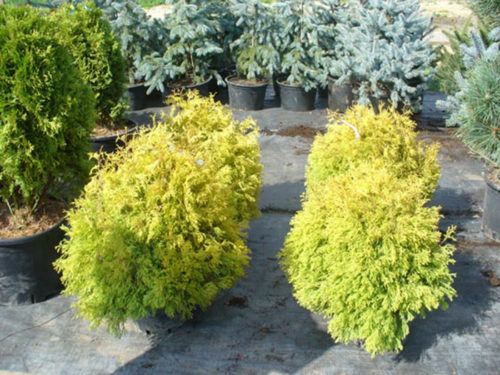
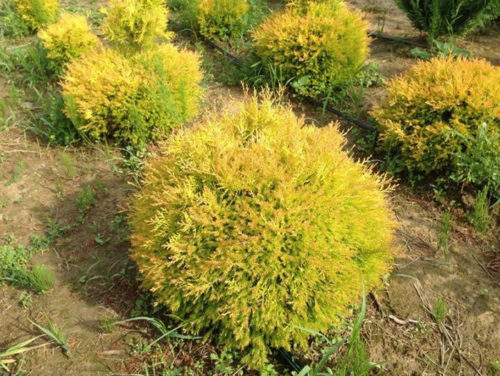
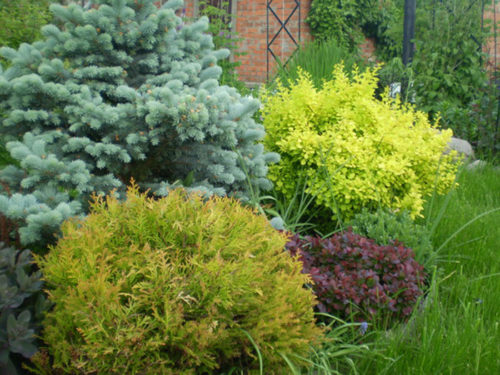
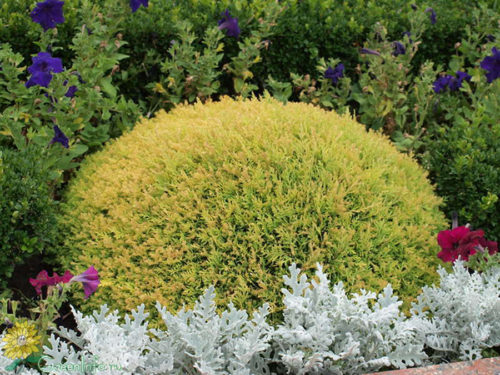












 Start a discussion ...
Start a discussion ...